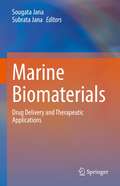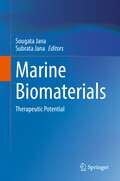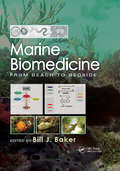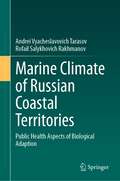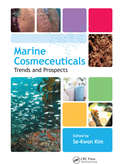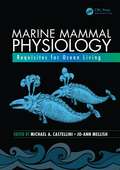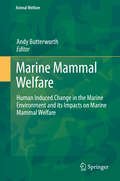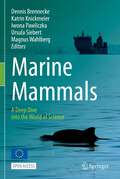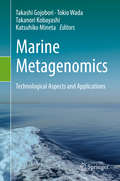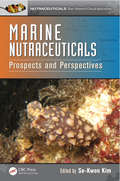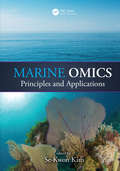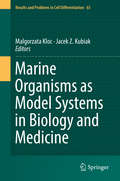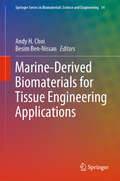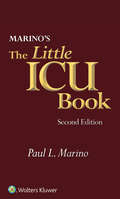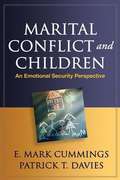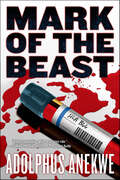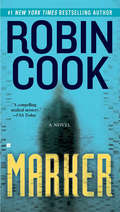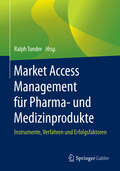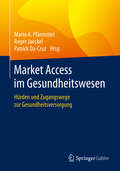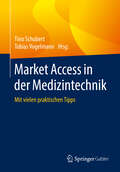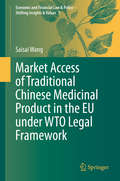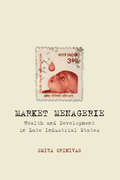- Table View
- List View
Marine Biomaterials: Drug Delivery and Therapeutic Applications
by Sougata Jana Subrata JanaThis book is focused on marine based biomedical carriers for delivery of therapeutics. Marine biomaterials and bio-based carriers show wide applications in pharmaceutical as well as biomedical fields for delivery of small and large molecules. Biomaterial-based composites, scaffolds or matrix systems are promising systems for controlled and prolonged release of drug in target site and control the premature release of drugs or bioactive compounds. This book discusses the targeted delivery of drugs and therapeutic applications. It also describes the use of marine biopolymers in cancer therapy. Different chapters describe the tissue engineering techniques to develop these carriers. The marine biomaterial-based systems are widely used for tissue engineering, and biomedical imaging. This book is meant for industry experts, students and researchers in the area of pharmaceutical sciences, biomedical engineering and material science and pharmacology.
Marine Biomaterials: Therapeutic Potential
by Sougata Jana Subrata JanaThis book provides updated information on marine-based biomedical carriers and their therapeutic potential. Marine biomaterials and bio-based carriers show wide application in pharmaceutical and biomedical fields to deliver small and large molecules. Biomaterial-based composites, scaffolds, or matrix systems are sound systems for controlled and prolonged drug release in target sites and control the premature release of drugs or bioactive compounds. This book discusses essential topics such as the therapeutic potential of marine collagen, management of bone disorders, gene delivery, natural marine compounds in immunomodulation, theranostic applications, tissue engineering, and regeneration. It also describes the use of marine biopolymers in cancer therapy. Different chapters describe the tissue engineering techniques to develop these carriers. Marine biomaterial-based systems are popular for tissue engineering and biomedical imaging.This book is ideal for industry experts, students, and researchers in pharmaceutical sciences and pharmacology.
Marine Biomedicine: From Beach to Bedside
by Bill J. BakerMarine Biomedicine: From Beach to Bedside assesses current efforts in marine biomedicine and evaluates the implications of recent advances on the future of the field.Richly illustrated in full color to enhance reader comprehension, the book covers four sections. The first one addresses the technology that has recently been brought to bear on the st
Marine Climate of Russian Coastal Territories: Public Health Aspects of Biological Adaption
by Andrei Vyacheslavovich Tarasov Rofail Salykhovich RakhmanovThe monograph was written based on the material of the post-doctoral thesis prepared under the supervision of Prof. Dr. Rakhmanov and it has been translated from its original version in Russian. It presents a comprehensive analysis of the process of biological adaptation and adaptation capacity of the population to the marine climate of Russia’s North, the Black and Caspian Sea regions and the Baltic Sea coast. The authors explore different biological reactions to adaptation and offer their classification depending on the type of climate. Special attention is given to the prevention of prenosological conditions and diseases typical of coastal areas. Evidence suggests that the human body has a remarkable capacity to adapt to a range of climatic and weather conditions through a variety of targeted adaptation measures.
Marine Cosmeceuticals: Trends and Prospects
by Se-Kwon KimMarine Cosmeceuticals: Trends and Prospects is a consolidated overview of the marine environment as a productive source of novel cosmeceuticals. It accumulates the latest research in this field from around the globe, highlighting the potential of marine micro and macro flora and fauna as effective agents for the development of novel cosmeceuticals.
Marine Glycobiology: Principles and Applications
by Se-Kwon KimMarine glycobiology is an emerging and exciting area in the field of science and medicine. Glycobiology, the study of the structure and function of carbohydrates and carbohydrate-containing molecules, is fundamental to all biological systems and represents a developing field of science that has made huge advances in the last half-century. This book revolutionizes the concept of marine glycobiology, focusing on the latest principles and applications of marine glycobiology and their relationships.
Marine Mammal Physiology: Requisites for Ocean Living (CRC Marine Biology Series)
by Michael A. Castellini Jo-Ann MellishSuppose you were designing a marine mammal. What would you need to think about to allow it to live in the ocean? How would you keep it warm? What would you design to allow it to dive for very long periods to extreme depths? Where would it find water to drink? How would you minimize the cost of swimming, and how would it find its prey in the deep an
Marine Mammal Welfare
by Andy ButterworthMarine mammals attract human interest – sometimes this interest is benign or positive – whale watching, conservation programmes for whales, seals, otters, and efforts to clear beaches of marine debris are seen as proactive steps to support these animals. However, there are many forces operating to affect adversely the lives of whales, seals, manatees, otters and polar bears – and this book explores how the welfare of marine mammals has been affected and how they have adapted, moved, responded and sometimes suffered as a result of the changing marine and human world around them. Marine mammal welfare addresses the welfare effects of marine debris, of human traffic in the oceans, of noise, of hunting, of whale watching and tourism, and of some of the less obvious impacts on marine mammals – on their social structures, on their behaviours and migration, and also of the effects on captivity for animals kept in zoos and aquaria. There is much to think and talk about – how marine mammals respond in a world dramatically influenced by man, how are their social structures affected and how is their welfare impacted?
Marine Mammals: A Deep Dive into the World of Science
by Dennis Brennecke Katrin Knickmeier Iwona Pawliczka Ursula Siebert Magnus WahlbergThis highly-readable Open Access textbook provides basic background information about marine mammals and anthropogenic impacts on them. The book includes inspiring exercises for education school programs in natural sciences. The book also provides advice on career paths using case studies of marine scientists and veterinarians describing their journeys from student to profession. By sharing real-life career paths, readers find answers to questions such as “What needs to be considered when choosing a career in science?” and “What kind of tasks do scientists undertake on a daily basis?” Marine mammals are amongst some of the most celebrated creatures on Earth, with their high intelligence, social and communicating skills, and capacity for deep diving. Alongside general information about marine mammals, the book aims at generating awareness of the impact of litter and noise pollution on the marine environment using marine mammals as an example. Huge numbers of marine animals, including marine mammals, die every year from entanglement in fishing gear, by ingestion of litter or because of chemical pollution. In the last decade many technological and scientific tools have been developed to aid research, for instance miniaturised sound recorders which can be attached to cetaceans and seals and record noise levels around them, their vocal production as well as their diving behaviour. This Open Access textbook can be used by undergraduate students interested in the fundamentals of marine mammal biology and medicine, and in pursuing the profession of a marine scientist.
Marine Metagenomics: Technological Aspects and Applications
by Takashi Gojobori Tokio Wada Takanori Kobayashi Katsuhiko MinetaThis book presents the state-of-art marine metagenome research and explains the method of marine metagenomic analysis in an easy-to-understand manner.Changes in the marine environment due to global warming and pollution have become a major global problem. Maintaining a healthy marine ecosystem requires advanced environmental monitoring and assessment systems. As such, the book presents a novel metagenomic monitoring method, which has been developed for comprehensive analyses of the DNA of microorganisms living in seawater to further our understanding of the dynamics of the marine environment. The book can be used as a primer for new researchers and as a manual on experimental methods.
Marine Niche: Translational Research
by Chaitanya G. Joshi Neelam M Nathani Chandrashekar Mootapally Indra R. Gadhvi Bharat MaitreyaThis book offers a comprehensive study of biological molecules acquired from marine organisms, which have been exploited for drug discovery with the aim to treat human diseases. Biomolecules have potential impacts on a diverse range of fields, including medical and pharmaceutical science, industrial science, biotechnology, basic research, molecular science, environmental science and climate change, etc. To understand and effectively apply medicinally important biomolecules, multidisciplinary approaches are called for. The ocean remains a rich biological resource, and the vast untapped potential of novel molecules from marine bio-resources has caught the interest of more and more researchers. These novel biological compounds have never been found in terrestrial or other ecosystems, but only in this rich niche. Advances in sampling techniques and technologies, along with increased funding for research and nature conservation, have now encouraged scientists to look deeper in the waters. Aquaculture supports both tremendous seafood production and the bulk production of marine-derived drugs. Furthermore, molecular methods are now being extensively employed to explore the untapped marine microbial diversity. With the help of molecular and biotech tools, the ability of marine organisms to produce new biosynthetic drugs can be greatly enhanced. This book provides an extensive compilation of the latest information on marine resources and their undisputedly vital role in the treatment of diverse ailments.
Marine Nutraceuticals: Prospects and Perspectives (Nutraceuticals)
by Se-Kwon KimThere is a great deal of consumer interest in natural bioactive substances due to their health benefits. Offering the potential to provide valuable nutraceuticals and functional food ingredients, marine-derived compounds are an abundant source of nutritionally and pharmacologically active agents, with both chemical diversity and complexity. Functio
Marine OMICS: Principles and Applications
by Se-Kwon KimThis book provides comprehensive coverage on current trends in marine omics of various relevant topics such as genomics, lipidomics, proteomics, foodomics, transcriptomics, metabolomics, nutrigenomics, pharmacogenomics and toxicogenomics as related to and applied to marine biotechnology, molecular biology, marine biology, marine microbiology, environmental biotechnology, environmental science, aquaculture, pharmaceutical science and bioprocess engineering.
Marine Organisms as Model Systems in Biology and Medicine (Results and Problems in Cell Differentiation #65)
by Jacek Z. Kubiak Malgorzata KlocThis book highlights the potential advantages of using marine invertebrates like tunicates, echinoderms, sponges and cephalopods as models in both biological and medical research. Bioactive compounds found in marine organisms possess antibacterial, antifungal, anti-diabetic and anti-inflammatory properties, and can affect the immune and nervous systems. Despite substantial research on the medicinal attributes of various marine invertebrates, they are still very much underrepresented in scientific literature: the majority of cell, developmental and evolutionary scientific journals only publish research conducted on a few well-known model systems like Drosophila melanogaster or Xenopus laevis. Addressing that gap, this book introduces readers to new model organisms like starfish or nemertera. By showing their benefits with regard to regeneration, stem cell research and Evo-Devo, the authors provide a cross-sectional view encompassing various disciplines of biological research. As such, this book will not only appeal to scientists currently working on marine organisms, but will also inspire future generations to pursue research of their own.
Marine Pharmacognosy: Trends and Applications
by Se-Kwon KimDiverse and abundant, marine-derived bioactive compounds offer a plethora of pharmacologically active agents with the potential to produce valuable therapeutic entities. Marine-derived organisms, including some macroalgae, microalgae, blue-green algae, invertebrates, and vertebrates-valued in traditional Chinese medicine since ancient times-are now
Marine-Derived Biomaterials for Tissue Engineering Applications (Springer Series in Biomaterials Science and Engineering #14)
by Besim Ben-Nissan Andy H. ChoiThis book presents the latest advances in marine structures and related biomaterials for applications in both soft- and hard-tissue engineering, as well as controlled drug delivery. It explores marine structures consisting of materials with a wide variety of characteristics that warrant their use as biomaterials. It also underlines the importance of exploiting natural marine resources for the sustainable development of novel biomaterials and discusses the resulting environmental and economic benefits. The book is divided into three major sections: the first covers the clinical application of marine biomaterials for drug delivery in tissue engineering, while the other two examine the clinical significance of marine structures in soft- and hard-tissue engineering, respectively. Focusing on clinically oriented applications, it is a valuable resource for dentists, oral and maxillofacial surgeons, orthopedic surgeons, and students and researchers in the field of tissue engineering.
Marino's The Little ICU Book
by Paul L. Marino Samuel M. GalvagnoQuick lookup for the most essential info in critical care! Ideal for quick reference at the bedside, The Little ICU Book is a condensed, compact version of The ICU Book, Dr. Marino’s best-selling comprehensive intensive care reference.The Little ICU Book zeroes in on only the essentials for the hands-on care of critically ill adult patients. Its fast-access format makes it an indispensible resource for residents as well as busy critical care physicians.
Marital Conflict and Children
by Patrick Davies E. Mark CummingsFrom leading researchers, this book presents important advances in understanding how growing up in a discordant family affects child adjustment, the factors that make certain children more vulnerable than others, and what can be done to help. It is a state-of-the-science follow-up to the authors' seminal earlier work, Children and Marital Conflict The Impact of Family Dispute and Resolution. The volume presents a new conceptual framework that draws on current knowledge about family processes; parenting; attachment; and children's emotional, physiological, cognitive, and behavioral development. Innovative research methods are explained and promising directions for clinical practice with children and families are discussed.
Mark of the Beast
by Adolphus AnekweMark of the Beast: A searing medical thriller by Adolphus A. Anekwe, a renowned doctor, about the ramifications of isolating a gene that causes violent behavior Dr. Regina Dickerson is a Catholic physician in San Diego who has discovered that there is a certain genetic marker that indicates the carrier is prone to psychotic violence. Working on blood from prison inmates, her theory begins to prove itself time and again with violent offenders. The variety of crimes is diverse: one couple murders their children for organ money, another man kidnaps young girls to seduce and kill them, yet another has a penchant for cyanide. As Dickerson's work begins to show results and catches the attention of the media, people begin to fear that witch hunts and Spanish Inquisition–style mayhem will result if forcible testing is carried out. Meanwhile, a race begins to find a cure. With science and religion at odds, Dickerson must find her own answers while trying to escape those who want to put an end to her inflammatory research. At the Publisher's request, this title is being sold without Digital Rights Management Software (DRM) applied.
Marker (Jack Stapleton / Laurie Montgomery #5)
by Robin CookWith his signature blend of suspense and science, Robin Cook delivers an electrifying page-turner that delves into the murky ethics of developing genomic medicine and modern-day health care.
Market Access Management für Pharma- und Medizinprodukte: Instrumente, Verfahren und Erfolgsfaktoren
by Ralph TunderDie pharmazeutische Industrie steht im deutschen Gesundheitswesen häufig im Mittelpunkt kontroverser Kostendiskussionen. Als Resultat zielten die Maßnamen der Gesundheitspolitik in den letzten Jahren vorrangig auf (Kosten-)regulierungen der Arzneimittelindustrie ab, deren bisheriger Höhepunkt die Einführung des AMNOG im Jahr 2011 darstellte. Die bis dato freie Preisbildung wurde abgelöst durch ein zweistufiges Verfahren bestehend aus Nutzenbewertung und Preisverhandlung. Diese gravierenden Veränderungen der gesetzlichen Rahmenbedingungen für die Arzneimittelindustrie hatten einen erheblichen Bedeutungszuwachs des Themas Market Access zur Folge. Die Motivation zur Erstellung des Buches ist es, eine Publikation zu schaffen, die nicht nur den aktuellen Status widerspiegelt, sondern vielmehr auch die wesentlichen Instrumente und Verfahrensweisen aufzeigt und auch kritisch hinterfragt. Der Leser soll so einen Einblick in die Materie als auch nötiges Rüstzeug bei der konkreten Umsetzung erlangen. Das Buch dient dazu, Market Access Managern oder Interessierten fundiertes Hintergrundwissen zu vermitteln.
Market Access im Gesundheitswesen: Hürden und Zugangswege zur Gesundheitsversorgung
by Mario A. Pfannstiel Patrick Da-Cruz Roger JaeckelDer Zugang zu medizinischen Versorgungsleistungen im Gesundheitswesen ist mit Chancen, Herausforderungen, Reformen, Barrieren und Lösungsansätzen verbunden, die sich zunehmend durch neue Produkte und Dienstleistungen und durch die digitale Transformation der Branche ergeben. Auch ressourcenbezogene Handlungsfelder bilden für den Market Access eine zunehmend stärker zu beachtende Steuerungsgröße, um die Grundlagen für eine bedarfsgerechte Versorgung zu schaffen. Besondere Herausforderungen ergeben sich im Kontext von Arzneimitteln und Medizinprodukten: Aspekte der Zulassungsharmonisierung im europäischen Kontext gewinnen künftig an Bedeutung. Eine zentrale Frage besteht in diesem Zusammenhang in der Nutzenbewertung von Produkten, die sowohl medizinische als auch ökonomische und sonstige Nutzenkategorien umfassen. Da die Industrie zunehmend Lösungspakete anbietet, die aus Produkten und Dienstleistungen bestehen, müssen Verfahren der Nutzenbewertung entsprechend weiterentwickelt werden. Digitale Begleitangebote für Produkte erweitern abermals die Nutzenpositionen und müssen ebenfalls berücksichtigt werden, wie auch die zunehmende Individualisierung von Therapien weitere Fragen aufwirft. Das vorliegende Fachbuch setzt sich mit den genannten Rahmenbedingungen medizinischer Versorgung und mit der Nutzen- und Methodenbewertung neuer Arzneimittel und Medizinprodukte auseinander. Entscheidungsträger aus der Gesundheitspolitik, Wissenschaftler sowie Verantwortliche aus den Versorgungsbereichen und dem öffentlichen Sektor erhalten wertvolle Hinweise und Anregungen.
Market Access in der Medizintechnik: Mit vielen praktischen Tipps
by Tino Schubert Tobias VogelmannDer Marktzugang von Medizinprodukten wird zunehmend komplexer. Einerseits werden Produkte technisch immer anspruchsvoller, andererseits wandeln sich die nationalen und internationalen Regulierungen zur Zulassung kontinuierlich. Zu einem erfolgreichen Marktzugang gehört neben der Zulassung aber auch die Erstattungsfähigkeit durch die gesetzliche Krankenversicherung. Dieses Buch hat daher den Anspruch, praktische Hinweise zur Zulassung und Erstattung für Ihre Marktzugangsstrategien zu geben.
Market Access of Traditional Chinese Medicinal Product in the EU under WTO Legal Framework (Economic and Financial Law & Policy – Shifting Insights & Values #5)
by Saisai WangThis book presents an in-depth analysis of issues in trade law and EU pharmaceutical law concerning market access for traditional Chinese medicinal products. It discusses these issues from the standpoints of fundamental law, international law and EU law, so to offer a comprehensive perspective. Specifically, it points out the core legislative issues for EU policymakers who deal with market access for traditional medicinal products; describes the relation between law and science; and offers essential information on herbal medicinal product registration in the EU. Further, it compares EU law and Chinese law in this regard, which can offer inspirations for readers from other counties that have similar medicinal products. The book uses straightforward, accessible language to break down the key issues involved.
Market Menagerie: Health and Development in Late Industrial States
by Smita SrinivasMarket Menagerieexamines technological advance and market regulation in the health industries of nations such as India, Brazil, South Africa, Nigeria, and China. Pharmaceutical and life science industries can reinforce economic development and industry growth, but not necessarily positive health outcomes. Yet well-crafted industrial and health policies can strengthen each other and reconcile economic and social goals. This book advocates moving beyond traditional market failure to bring together three uncommonly paired themes: the growth of industrial capabilities, the politics of health access, and the geography of production and redistribution.
